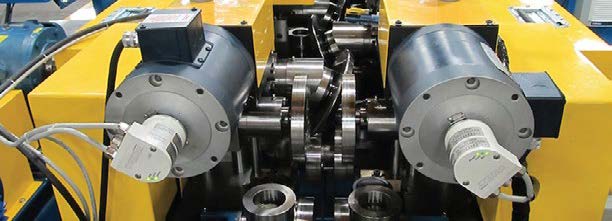Rotary units are operated in one of four different ways:
1. The rotary unit has its own drive system and can operate faster than the line speed. It generates a free loop between itself and the roll former. However, this configuration is rarely used to avoid starting and stopping the rotary unit or roll former.
2. The rotary unit has no drive system at all. The strip usually is handcranked through the rotary puncher and hand-fed into the roll former to start up the line. Then the unit rotates as the punches enter the material continuously, or as the rolls pinch the stock continuously and the roll former pulls the stock.
3. A combination of the self-driven unit and the no-drive system unit is used with an overriding clutch to start up the unit without snapping the material. Then as the roll forming machine picks up speed, the overriding clutch provides the power, so that the rotary motor no longer needs to input the power, no matter how fast the roll former is running.
4. A computer-controlled servo amplifier-drive system drives the top or bottom roll via programmable motion control software and a rotary encoder.
Advantages and Applications
Rotary punch equipment costs can be low, because these pull-through units do not require sophisticated feeds normally associated with highspeed presses. In addition, minimal floor space is required because no feed system or punch press is needed and the rotary punch unit is compact-typically about 3 by 3 feet.
Space can be conserved even more if the rotary unit is mounted inside the roll former. A rotary unit is relatively quiet. Vibration is minimal, because it shears through the material progressively in a radial motion rather than all at once, as a punching die does.
Another advantage is its low maintenance requirements. Because its punch and die wear is spread over the roll diameter, the rotary punch unit usually can punch material for a very long time before sharpening and maintenance are needed.



